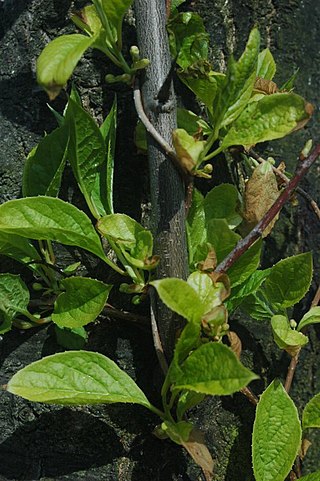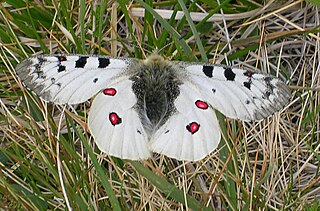
Schisandra, the magnolia vines, is a genus of twining shrubs that generally climb on other vegetation. Various authors have included the plants in the Illiciaceae

Lespedeza is a genus of some 45 species of flowering plants in the pea family (Fabaceae), commonly known as bush clovers or Japanese clovers (hagi). The genus is native to warm temperate to subtropical regions of eastern North America, eastern and southern Asia and Australasia.

The Parnassiinae or snow Apollos are a subfamily of the swallowtail butterfly family, Papilionidae. The subfamily includes about 50 medium-sized, white or yellow species. The snow Apollos are high-altitude butterflies and are distributed across Asia, Europe and North America.

Aucuba is a genus of three to ten species of flowering plants, now placed in the family Garryaceae, although formerly classified in the Aucubaceae or Cornaceae.

Astilbe is a genus of 18 species of rhizomatous flowering plants within the family Saxifragaceae, native to mountain ravines and woodlands in Asia and North America. Some species are known by the common names false goat's beard and false spirea.

The genus Helwingia consists of shrubs or rarely small trees native to eastern Asia, the Himalayas, and northern Indochina. It is the only genus in the family Helwingiaceae.

The Chinese mystery snail, black snail, or trapdoor snail, is a large freshwater snail with gills and an operculum, an aquatic gastropod mollusk in the family Viviparidae. The Japanese variety of this species is black and usually a dark green, moss-like alga covers the shell.

Luehdorfia chinensis, the Chinese luehdorfia, is a species of butterfly in the family Papilionidae. It is endemic to China.

The Japanese luehdorfia is a species of butterfly in the subfamily Parnassiinae of Papilionidae. It is found only in Japan. It was discovered by Yasushi Nawa in Japan's Gifu Prefecture in 1883. It is also known as the Gifu butterfly

Itea is a genus of about 10 species of shrubs and small trees, commonly called sweetspires. The leaves are alternate. Flowers are small, with 5 sepals and 5 petals, borne in racemes or spikes.

Kadsura is a genus of woody vines in the Schisandraceae described as a genus in 1810.

Chionographis is a genus of plants in the Melanthiaceae first described as a genus in 1867. This genus is native to China, Japan, and Korea.
L. japonica may refer to:
Eteoryctis deversa is a moth of the family Gracillariidae and genus Eteoryctis. It is known to live in India, Japan, Korea, the Russian Far East, and Taiwan.

Old World quail is a collective name for several genera of mid-sized birds in the tribe Coturnicini of the pheasant family Phasianidae. Although all species commonly referred to as "Old World quail" are in the same tribe, they are paraphyletic with respect to the other members of the tribe, such as Alectoris, Tetraogallus, Ammoperdix, Margaroperdix, and Pternistis.

Barnardia is a small genus of bulbous flowering plants in the family Asparagaceae, subfamily Scilloideae. The genus has two species, one found in the Balearic Islands and north-west Africa, the other in east China, Korea, Japan and adjacent localities. It was suggested in 2012 that the two species were not closely related.

Luehdorfia puziloi is a butterfly of the family Papilionidae. It was described by Nikolay Grigoryevich Erschoff in 1872. It is found in Manchuria, the Russian Far East (Ussuri), North Korea, South Korea, Japan and the Kuriles.

Oxya is a genus of grasshoppers found in Africa and Asia.
This page is based on this
Wikipedia article Text is available under the
CC BY-SA 4.0 license; additional terms may apply.
Images, videos and audio are available under their respective licenses.
















